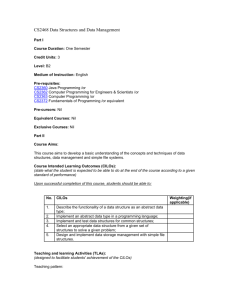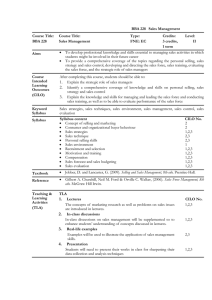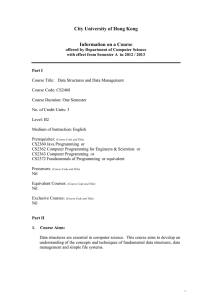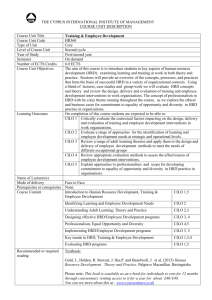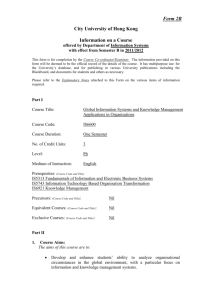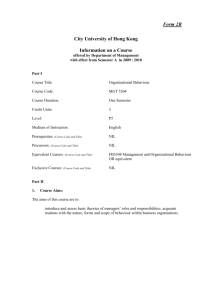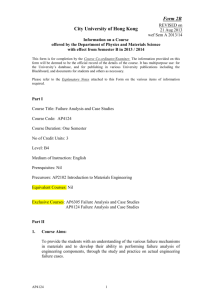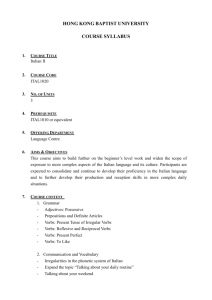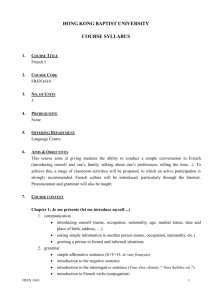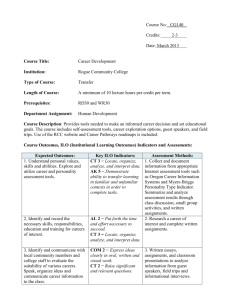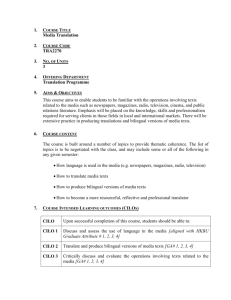CITY UNIVERSITY OF HONG KONG
advertisement
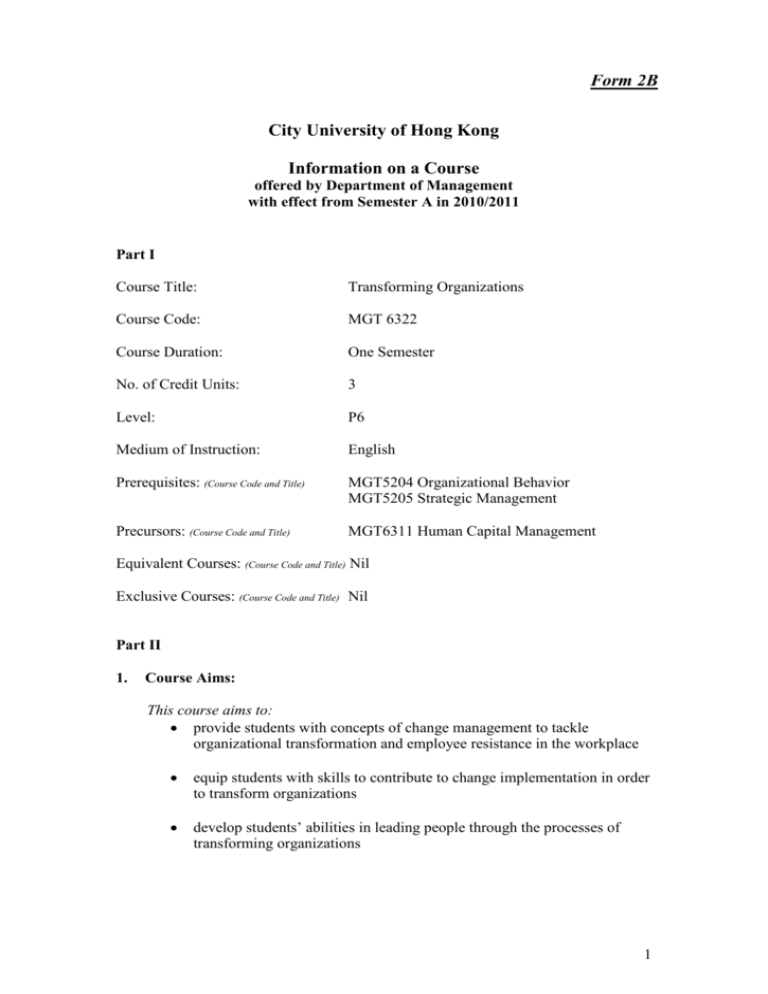
Form 2B City University of Hong Kong Information on a Course offered by Department of Management with effect from Semester A in 2010/2011 Part I Course Title: Transforming Organizations Course Code: MGT 6322 Course Duration: One Semester No. of Credit Units: 3 Level: P6 Medium of Instruction: English Prerequisites: (Course Code and Title) MGT5204 Organizational Behavior MGT5205 Strategic Management Precursors: (Course Code and Title) MGT6311 Human Capital Management Equivalent Courses: (Course Code and Title) Nil Exclusive Courses: (Course Code and Title) Nil Part II 1. Course Aims: This course aims to: provide students with concepts of change management to tackle organizational transformation and employee resistance in the workplace equip students with skills to contribute to change implementation in order to transform organizations develop students’ abilities in leading people through the processes of transforming organizations 1 2. Course Intended Learning Outcomes (CILOs) (state what the student is expected to be able to do at the end of the course according to a given standard of performance) Upon successful completion of this course, students should be able to: No. CILOs 1. Identify organization stakeholders’ reactions to different types of changes in the workplace Identify the reasons for organizational change failure and evaluate the preparations for effective change Evaluate means of communicating change to employees and how to cope with resistant sentiments Apply concepts of organizational culture and change management models to evaluate processes of change implementation Evaluate change leadership skills required for organization mission and vision delivery 2. 3. 4. 5. 3. Weighting (if applicable) 20% 20% 20% 20% 20% Teaching and learning Activities (TLAs) (designed to facilitate students’ achievement of the CILOs) Total Hours: Seminar 39 4. ILO No TLA 1: Seminar TLA 2: Tutorial & Group Project TLA 3: Outside classroom activity CILO 1 CILO 2 CILO 3 CILO 4 CILO 5 2 2 2 2 2 2 2 2 2 1 1 1 2 2 2 Remarks 1. Minor focus on the ILO 2. Major focus on the ILO Assessment Tasks/Activities (designed to assess how well the students achieve the CILOs) Coursework: 70% , Final Exam: 30% (2 Hours) ILO No Assessment task 1 Group project (30%) Assessment tasks 2&3 (40%) Assessment task 3 Final exam (30%) CILO 1 CILO 2 CILO 3 CILO 4 CILO 5 2 2 1 2 1 2 2 2 2 2 2 2 2 2 2 Remarks 1. Minor focus on the ILO 2. Major focus on the ILO 2 5. Grading of Student Achievement: Refer to Grading of Courses in the Academic Regulations (Attachment) and to the Explanatory Notes. ASSESSING AND GRADING CLASS PARTCIPATION Criteria Marginal D 1.0 A. Preparation Student is almost never prepared for class with assignments and required class materials. Adequate Student is occasionally prepared for class with assignments and C- 1.7 required class materials. C 2.0 C+ 2.3 Student is frequently prepared for Good class with assignments and B- 2.7 required class materials. B 3.0 B+ 3.3 Excellent Student is almost always prepared A- 3.7 for class with assignments and required class materials. A 4.0 A+ 4.3 B. Engagement Student almost never contributes to class by offering ideas and/or asking questions. Student occasionally makes contribution by offering seemingly useful/suitable ideas and/or asking meaningful questions. Student frequently contributes suitably in class by offering ideas and/or asking meaningful questions. Student almost always contributes meaningfully in class by offering ideas and/or asking questions in almost each class. ASSESSING AND GRADING APPLIED CASE ASSIGNMENTS Marginal D 1.0 Adequate C1.7 C 2.0 C+ 2.3 Good B2.7 B 3.0 B+ 3.3 Excellent A3.7 A 4.0 A+ 4.3 Pieces of evidence are relevant and accurate, but analyses are isolated, addressing a limited number of issues. Demonstration of understanding in a minimally acceptable way. Insufficient coverage, little originality, weak justification of solutions or recommendations. The evidence is relevant, accurate. However, there is little evidence of an overall extensive view of the case issues. Able to discuss content meaningfully but little application or integration of items. Fair justification of solutions or recommendations. The evidence presents a good appreciation of the general thrust of the case with relevant and accurate support of concepts taught in class. A clear view of how various aspects of the case integrate to form a purpose. Solutions or recommendations well justified. As in B, but with higher degree of originality and even good evidence of reflection on own performance based on theory. Generalizes principles, models or practices to new and unfamiliar real-life contexts. 3 ASSESSING CONCEPTUAL ASSIGNMENT [GROUP PRESENTATION] Marginal D 1.0 Adequate C1.7 C 2.0 C+ 2.3 Good B2.7 B 3.0 B+ 3.3 Excellent A3.7 A 4.0 A+ 4.3 Presents enough to describe what the issues are about. Some relevant points, however only re-describes the factual elements in a wooden manner, mainly pro and con. Uses a few mainstream references and applies correct concepts. Presentation describes topic, refers to what is proposed to be done. More relevant points drawn from prevalent models or conceptual frameworks, evidence of grasp of issues but has some difficulty in finding resolution or engaging in critical analysis. As in C, but also shows logical progression and possibly new and original insights. Most/all relevant points drawn from prevalent models or conceptual frameworks, uses appropriate structure to resolve issues with convincing arguments and discussion. Interesting and suitably complex account of analysis/solution demonstrating original contribution, going well beyond standard resources/ references / concepts, stating a point of view in one’s own voice. Suitably impresses with critical analysis in the judgment of the marker. Part III Keyword Syllabus: Types of change in organizations; Understanding concepts of change management; Communication strategies in change management process; Vision and mission statements of organization and change; Preparations for change in the workplace; Coping with employee resistance to change; Organizational culture and change; Implementing change; Models of change execution; Leadership skills in organizational change process. Reference Texts Beitler, M. (2006) Strategic Organizational Change: A Practitioner’s Guide for Managers and Consultants, 2nd Ed. New York: Practitioner Press International. Cameron E. and M. Green (2009) Making Sense of Change Management, 2nd Ed. London: Kogan Page. Carnall, C. (2007) Managing Change in Organizations. 5th ed. London: FT Prentice Hall. Hayes, J. (2007) The Theory and Practice of Change Management. 2nd ed. London: Palgrave Macmillan. Helms-Mills, J., K. Dye, and A. J. Mills (2009). Understanding Organizational Change. New York: Routledge. Leban, B. and L. Stone. (2008) Managing Organizational Change. Hoboken, NJ: John Wiley & Sons. 4 Palmer, I., R. Dunford and G. Akin (2009) Managing Organizational Change. 2nd ed. New York: McGraw-Hill. Senior B. and J. Fleming (2006). Organizational Change. 3rd ed. Harlow: Prentice Hall. Spector, B. (2010) Implementing Organizational Change. Upper Saddle River, NJ: Prentice Hall. Returned by: Name: Dr. Andrew Chan Department: Management Tel: Date: 15 April, 2009 3442 6208 5
